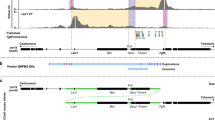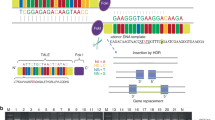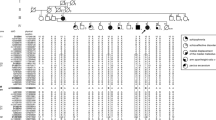Abstract
Split-hand/foot malformation (SHFM) is a congenital limb deformity due to the absence or dysplasia of central rays of the autopod. Six SHFM loci have already been identified. Here we describe a Chinese family with autosomal-dominant SHFM1 that has previously been mapped to 7q21.2-21.3. The two affected family members, mother and son, showed deep median clefts between toes, ectrodactyly and syndactyly; the mother also showed triphalangeal thumbs. Exome sequencing and variant screening of candidate genes in the six loci known to be responsible for SHFM revealed a novel heterozygous mutation, c.558G>T (p.(Gln186His)), in distal-less homeobox 5 (DLX5). As DLX5 encodes a transcription factor capable of transactivating MYC, we also tested whether the mutation could affect DLX5 transcription acitivity. Results from luciferase reporter assay revealed that a mutation in DLX5 compromised its transcriptional activity. This is the first report of a mutation in DLX5 leading to autosomal-dominant SHFM1.
Similar content being viewed by others
Log in or create a free account to read this content
Gain free access to this article, as well as selected content from this journal and more on nature.com
or
References
van Bokhoven H, Hamel BC, Bamshad M et al: p63 Gene mutations in eec syndrome, limb-mammary syndrome, and isolated split hand-split foot malformation suggest a genotype-phenotype correlation. Am J Hum Genet 2001; 69: 481–492.
Ianakiev P, Kilpatrick MW, Toudjarska I, Basel D, Beighton P, Tsipouras P : Split-hand/split-foot malformation is caused by mutations in the p63 gene on 3q27. Am J Hum Genet 2000; 67: 59–66.
Brunner HG, Hamel BC, Van Bokhoven H : The p63 gene in EEC and other syndromes. J Med Genet 2002; 39: 377–381.
Robledo RF, Rajan L, Li X, Lufkin T : The Dlx5 and Dlx6 homeobox genes are essential for craniofacial, axial, and appendicular skeletal development. Genes Dev 2002; 16: 1089–1101.
Merlo GR, Paleari L, Mantero S et al: Mouse model of split hand/foot malformation type I. Genesis 2002; 33: 97–101.
Faiyaz-Ul-Haque M, Zaidi SH, King LM et al: Fine mapping of the X-linked split-hand/split-foot malformation (SHFM2) locus to a 5.1-Mb region on Xq26.3 and analysis of candidate genes. Clin Genet 2005; 67: 93–97.
de Mollerat XJ, Gurrieri F, Morgan CT et al: A genomic rearrangement resulting in a tandem duplication is associated with split hand-split foot malformation 3 (SHFM3) at 10q24. Hum Mol Genet 2003; 12: 1959–1971.
Ozen RS, Baysal BE, Devlin B et al: Fine mapping of the split-hand/split-foot locus (SHFM3) at 10q24: evidence for anticipation and segregation distortion. Am J Hum Genet 1999; 64: 1646–1654.
Roscioli T, Taylor PJ, Bohlken A et al: The 10q24-linked split hand/split foot syndrome (SHFM3): narrowing of the critical region and confirmation of the clinical phenotype. Am J Med Genet A 2004; 124A: 136–141.
Kano H, Kurosawa K, Horii E et al: Genomic rearrangement at 10q24 in non-syndromic split-hand/split-foot malformation. Hum Genet 2005; 118: 477–483.
Del Campo M, Jones MC, Veraksa AN et al: Monodactylous limbs and abnormal genitalia are associated with hemizygosity for the human 2q31 region that includes the HOXD cluster. Am J Hum Genet 1999; 65: 104–110.
Goodman FR, Majewski F, Collins AL, Scambler PJ : A 117-kb microdeletion removing HOXD9-HOXD13 and EVX2 causes synpolydactyly. Am J Hum Genet 2002; 70: 547–555.
Ugur SA, Tolun A : Homozygous WNT10b mutation and complex inheritance in Split-Hand/Foot Malformation. Hum Mol Genet 2008; 17: 2644–2653.
Khan S, Basit S, Zimri FK et al: A novel homozygous missense mutation in WNT10B in familial split-hand/foot malformation. Clin Genet 2012; 82: 48–55.
Ahmad M, Abbas H, Haque S, Flatz G : X-chromosomally inherited split-hand/split-foot anomaly in a Pakistani kindred. Hum Genet 1987; 75: 169–173.
Faiyaz ul Haque M, Uhlhaas S, Knapp M et al: Mapping of the gene for X-chromosomal split-hand/split-foot anomaly to Xq26-q26.1. Hum Genet 1993; 91: 17–19.
Celli J, Duijf P, Hamel BC et al: Heterozygous germline mutations in the p53 homolog p63 are the cause of EEC syndrome. Cell 1999; 99: 143–153.
Yang A, Kaghad M, Wang Y et al: p63, a p53 homolog at 3q27-29, encodes multiple products with transactivating, death-inducing, and dominant-negative activities. Mol Cell 1998; 2: 305–316.
Scherer SW, Poorkaj P, Allen T et al: Fine mapping of the autosomal dominant split hand/split foot locus on chromosome 7, band q21.3-q22.1. Am J Hum Genet 1994; 55: 12–20.
Crackower MA, Scherer SW, Rommens JM et al: Characterization of the split hand/split foot malformation locus SHFM1 at 7q21.3-q22.1 and analysis of a candidate gene for its expression during limb development. Hum Mol Genet 1996; 5: 571–579.
Velinov M, Ahmad A, Brown-Kipphut B et al: A 0.7 Mb de novo duplication at 7q21.3 including the genes DLX5 and DLX6 in a patient with split-hand/split-foot malformation. Am J Med Genet A 2012; 158A: 3201–3206.
Shamseldin HE, Faden MA, Alashram W, Alkuraya FS : Identification of a novel DLX5 mutation in a family with autosomal recessive split hand and foot malformation. J Med Genet 2012; 49: 16–20.
Merlo GR, Zerega B, Paleari L, Trombino S, Mantero S, Levi G : Multiple functions of Dlx genes. Int J Dev Biol 2000; 44: 619–626.
Xu J, Testa JR : DLX5 (distal-less homeobox 5) promotes tumor cell proliferation by transcriptionally regulating MYC. J Biol Chem 2009; 284: 20593–20601.
Han Y, San-Marina S, Liu J, Minden MD : Transcriptional activation of c-myc proto-oncogene by WT1 protein. Oncogene 2004; 23: 6933–6941.
Adzhubei IA, Schmidt S, Peshkin L et al: A method and server for predicting damaging missense mutations. Nat Methods 2010; 7: 248–249.
Ng PC, Henikoff S : Predicting deleterious amino acid substitutions. Genome Res 2001; 11: 863–874.
Vieux-Rochas M, Bouhali K, Mantero S et al: BMP-mediated functional cooperation between Dlx5;Dlx6 and Msx1;Msx2 during mammalian limb development. PLoS One 2013; 8: e51700.
Ferrari D, Harrington A, Dealy CN : Kosher RA: Dlx-5 in limb initiation in the chick embryo. Dev Dyn 1999; 216: 10–15.
Duboule D : Making progress with limb models. Nature 2002; 418: 492–493.
Saunders Jr JW : Is the progress zone model a victim of progress? Cell 2002; 110: 541–543.
Shimomura Y, Wajid M, Shapiro L, Christiano AM : P-cadherin is a p63 target gene with a crucial role in the developing human limb bud and hair follicle. Development 2008; 135: 743–753.
Witte F, Dokas J, Neuendorf F, Mundlos S, Stricker S : Comprehensive expression analysis of all Wnt genes and their major secreted antagonists during mouse limb development and cartilage differentiation. Gene Expr Patterns 2009; 9: 215–223.
Elliott AM, Evans JA : Genotype-phenotype correlations in mapped split hand foot malformation (SHFM) patients. Am J Med Genet A 2006; 140: 1419–1427.
Acknowledgements
We thank the family members for participating in our study, and Professor Joseph R Testa (Fox Chase Cancer Center, Philadelphia, PA) and Dr Mark D Minden (Department of Cellular and Molecular Biology, Ontario Cancer Institute, Toronto, Canada) for plasmids. This work was supported by grants from the Natural Science Foundation of China (81072452, 81273281) and Ph.D. Programs Foundation of Ministry of Education of China (20100131110035).
Author information
Authors and Affiliations
Corresponding author
Ethics declarations
Competing interests
The authors declare no conflict of interest.
Rights and permissions
About this article
Cite this article
Wang, X., Xin, Q., Li, L. et al. Exome sequencing reveals a heterozygous DLX5 mutation in a Chinese family with autosomal-dominant split-hand/foot malformation. Eur J Hum Genet 22, 1105–1110 (2014). https://doi.org/10.1038/ejhg.2014.7
Received:
Revised:
Accepted:
Published:
Issue date:
DOI: https://doi.org/10.1038/ejhg.2014.7
Keywords
This article is cited by
-
Limb development: a paradigm of gene regulation
Nature Reviews Genetics (2017)
-
Phenotypic subregions within the split-hand/foot malformation 1 locus
Human Genetics (2016)
-
Deletions of exons with regulatory activity at the DYNC1I1 locus are associated with split-hand/split-foot malformation: array CGH screening of 134 unrelated families
Orphanet Journal of Rare Diseases (2014)



